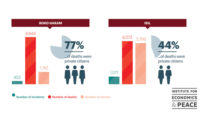8,400+ Terrorist Attacks in 2012

Although terrorism touched 85 countries in 2012, just three - Pakistan, Iraq and Afghanistan - suffered more than half of 2012's attacks (54 percent) and fatalities (58 percent), according to data by the National Consortium for the Study of Terrorism and Responses to Terrorism (START) Global Terrorism Database (GTD). The next five most frequently targeted countries were India, Nigeria, Somalia, Yemen and Thailand.
"While terrorist attacks have in large part moved away from Western Europe and North America to Asia, the Middle East and Africa, worldwide terrorism is reaching new levels of destructiveness," said Gary LaFree, START director and professor of criminology and criminal justice at UMD.
In addition to illustrating a continued shift in location of attacks, the new data—with more than 8,400 terrorist attacks killing more than 15,400 people in 2012—also show an increase in attacks and fatalities over the past decade. The previous record for attacks was set in 2011 with more than 5,000 incidents; for fatalities, the previous high was 2007 with more than 12,500 deaths.
In the 1970s, most attacks occurred in Western Europe. In the 1980s, Latin America saw the most terrorist acts. Beginning with the 1990s, South Asia, North Africa and the Middle East have seen steadily rising numbers of attacks, a trend that has accelerated in recent years.
Though al-Qaida central was not directly responsible for any attacks in 2012, the six deadliest terrorist groups in the world were all affiliated to some extent with the organization. These include the Taliban (more than 2,500 fatalities), Boko Haram (more than 1,200 fatalities), al-Qaida in the Arabian Peninsula (more than 960 fatalities), Tehrik-e Taliban Pakistan (more than 950 fatalities), al-Qaida in Iraq (more than 930 fatalities) and al-Shabaab (more than 700 fatalities).
Attacks in Yemen, Nigeria and Iraq were among the deadliest in 2012.
The database can be found here: http://www.start.umd.edu/gtd/
Looking for a reprint of this article?
From high-res PDFs to custom plaques, order your copy today!








